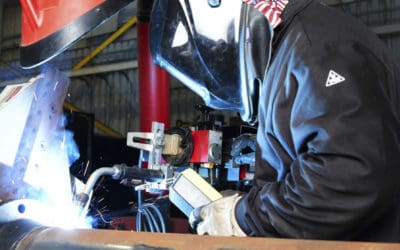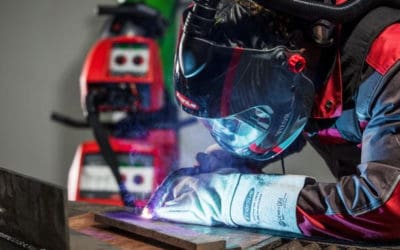Introduction
When welding procedures or welding performances (welders) are qualified, test pieces are prepared using a specific combination of parent material and consumables. To reduce the number of welding procedures to be qualified for production applications, codes and standards give provisions for a particular parent material and filler materials to cover a range of other materials considered to have similar weldability (ie to be affected by welding in a similar manner) or to require similar skills for performance (welder qualification). Codes and standards may directly spell out a particular system for material grouping or reference other codes and standards.
The two most commonly used grouping systems are provided by ISO (reference standard ISO/TR 15608, which superseded CR 12187) and ASME/AWS (ASME Section IX, QW/QB-422, identical to AWS B2.1).
The first classifies materials into ‘groups’ and ‘subgroups’, identified by a numeric value, whilst the second assigns ‘P-numbers’ (P-No, where ‘P’ is for parent material), as shown in Table 1 below.
The main difference between the two is that the ISO system allows any material within the scope of the reference standard to be assigned to a certain group, whereas the ASME system assigns a P-No only to materials listed in the code or that have the same UNS number as listed materials (see below for more details). The specific case of AWS d1.1 is described at the end of this job knowledge article.
| Materials Group | ISO/TR 15608 | ASME IX, QW-422 (welding) | ASME IX, QB-422 (brazing) |
| Steels | 1.y – 11.y | P-No. 1 – P-No. 15F | P-No. 101 – P-No. 103 |
| Aluminium and aluminium alloys | 2x.y | P-No. 21 – P-No. 26 | P-No. 104 and P-No. 105 |
| Copper and copper alloys | 3x.y | P-No. 31 – P-No. 35 | P-No. 107 and P-No. 108 |
| Nickel and nickel alloys | 4x.y | P-No. 41 – P-No. 49 | P-No. 110 – P-No. 112 |
| Titanium and titanium alloys | 5x.y | P-No. 51 – P-No. 53 | P-No. 115 |
| Zirconium and zirconium alloys | 6x.y | P-No. 61 and P-No. 62 | P-No. 117 |
| Cast irons | 7x.y | Not applicable | Not applicable |
Table 1: Comparison of material groups in accordance with ISO/TR 15608 and ASME IX.
Welder and Welding Operator Qualification Testing (EN 287, ISO 9606 and ISO 14732)
For welder qualification, ISO 9606 (which superseded EN 287) provides qualification ranges on both the parent and filler materials.
Newer versions of parts of ISO 9606, such as the current ISO 9606-1 (Fusion welding of steels) have moved away from this philosophy to adopt a system similar to ASME IX (described below), which considers the filler material composition as the only ‘important’ variable with a welder being qualified for a group of filler materials, as long as the parent material is within any group from 1 to 11 (see Table 1).
For welding operators, EN ISO 14732 relates to the operators of welding equipment. As the skills of the welder are not tested, the range of qualification ensue from the relevant welding procedure qualification (such as one in the next section).
Welding Procedure Qualification (ISO 15610, 15611, 15612, 15613 and 15614)
ISO standards generally allow a range of parent materials to be qualified, based on the material used for the qualification test piece.
This typically covers materials within the same group and any lower sub-group. A full listing of all of the qualification ranges is provided in the standards (usually as a table or matrix). If a material falls within two (sub-) groups, it is always considered to belong to the lower-numbered one. A wide range of dissimilar joints can qualify, but they need to be carefully examined to ensure the standard allows it.
Filler materials tested generally qualify other materials that have the same form, nominal composition, mechanical properties and hydrogen content. There are certain subtleties in some of the parts of the standard. In some cases, such as when toughness properties are required or for hyperbaric welding, only consumables of the same make are qualified. This is also the case in EN ISO 15610 where the properties of a consumable need to be guaranteed to rely on the qualification procedure.
Materials grouping (ISO/TR 15608)
This standard breaks up the possible materials that can be welded into a set of groups, to allow multiple different grades to be qualified by a single test weld.
The standard covers steels, aluminium alloys, copper alloys, nickel alloys, titanium alloys, zirconium alloys and cast irons. The majority of the groupings are relatively easy to understand, with composition ranges provided for the relevant alloys. The groupings are based on the intentional alloying components, not taking account of impurities.
The steel grouping considers additional factors: namely the yield strength of the alloy and its thermo-mechanical treatment. This can result in uncertainty in determining the exact grouping or sub-grouping of the alloy, and may require additional information to be considered beyond the composition or tensile properties. For example, S460 steels can come under several different standards. S460M, as specified in EN 10025-4, which relates to thermomechanical rolled steels, is in Group 2.1, whereas S460N, as specified in EN 10025-3, which relates to normalised steels, is in Group 1.3.
Due to the wide range of alloys available and the different standards covering them, assigning an alloy to a particular group within ISO/TR 15608 may prove difficult.
However, three standards exist that may be useful for determining the grouping for a material of interest. PD CEN ISO/TR 20172, 20173 and 20174 list many different grades of material and the group in which they sit. These standards can be very useful in determining the relevant group and therefore the range of qualification.
ASME Boiler and Pressure Vessel Code (Section IX)
Specifications for materials to be used within the ASME BPVC are provided in Section II of the code. These are a result of collaboration between ASME and ASTM, which have worked together in the preparation of material specifications adequate for safety in the field of pressure equipment constructed from ferrous and non-ferrous materials.
As a result, the ASME code has adopted ASTM material specifications with no changes, apart from an ‘SA’ identifier (eg ASTM A516 becomes SA-516).
The ASME grouping is made using the alphanumeric designation P-No for the base metal and F-numbers (F-No) for the filler material. This grouping is based on comparable characteristics of the material such as weldability, mechanical properties and composition.
The base metals are listed in the table QW/QB-422, which allows determination of what the P‑No of a certain material is, depending on its specification according to ASTM or its UNS number designation. Only materials accepted for use in the construction of pressurised components according to the ASME BPVC are listed in QW/QB-422, hence they can be assigned a P-No.
If a metal does not appear in the table QW/QB-422 it is considerate ‘unassigned’ and cannot be grouped under a P-No. If an unlisted material has the same UNS number as a listed material, the unlisted material belongs to the same P-No as the listed one. This list specifies for welding/brazing specification the ‘minimum specified tensile’ as the acceptance value for the tensile test for welding/brazing procedure qualification.
For some materials the table QW/QB-422 refers to assignment of materials in accordance with the grouping criteria of ISO/TR 15608:2005. This list of crossed reference is provided for information only as ASME section IX does not refer to this grouping as a basis to establish the qualification range of base metals qualified.
The table QW 424.1 gives the rules of range qualification determination depending on which base metal(s) are used for procedure qualification coupon in accordance with ASME BPVS section IX QW-424.1. The code also specifies that groupings of both base metal and filler material do not imply that any base metal and consumable can be substituted without consideration between the base and filler metal.
Table 2 complements Table 1 and provides additional information on the type of materials included within each P-No.
| P-No | Material |
| 1 | Carbon steel, Maximum C, 0.030;%, Si, 0.60%; Mn, 1.70%; S, 0.045%; P, 0.045% Other single elements, maximum 0.30% Sum of all other elements, maximum 0.80% |
| 2 | Wrought iron |
| 3 | Nominal 1/2% Mo and/or Cr alloy steel |
| 4 | Nominal l-1/4 % Cr, l/2% Mo, alloy steel |
| 5A | Nominal 2-1/4 and 3% Cr, 1 % Mo alloy steel |
| 5B | Nominal 5 to 10% Cr, 1 Mo alloy steel |
| 5C | All 5A and 5B metals heat treated |
| 6 | Martensitic stainless steel |
| 7 | Ferritic stainless steel |
| 8 | Austenitic stainless steel |
| 9A | 2 % Nickel alloy steel |
| 9B | 3.5% Nickel alloy steel |
| 9C | 4.5% Nickel alloy steel 8% and 9% Ni |
| 10A | Various low-alloy steels* |
| 10B | |
| 10C | |
| 11 | Low alloy steel, quenched and tempered |
| 15 | Creep-strength-enhanced ferritic steels |
Table 2: P-No system used by ASME for steel
*Includes carbon steels and low-alloy steels that have different weldability to common carbon steels or that have unique properties that do not fall within existing P-Nos
AWS system
AWS materials approved for prequalified welding procedure specification are listed in Table 3.1 of AWS D1.1 according to their ASTM specification.
Both parent materials and consumables are also classified in four groups, in AWS D1.1 Table 3.2, depending of their AWS classification and strength, to give guidance for matching strength with the base metal in the case of prequalified welding procedures.
In accordance with Table 4.8 all materials unlisted shall be qualified in conformance with clause 4 of the welding procedure qualification of AWS D1.1.
In the case of prequalified welding procedures only material listed in the four groups of Table 3.1 of AWS D1.1 can be used.
Table 4.8 specifies that requalification will be necessary if the material selected do not fall within the range qualified. The use of unlisted base metal is restricted to approval.
References
ISO/TR 15608L: Welding – Guidelines for a metallic materials grouping system, 2013
BS EN 287: Qualification test of welders – Fusion welding Part 1: Steels * Remains Current, 2011
BS EN ISO 9606: Qualification testing of welders — Fusion welding Part 1: Steels – CORR: January 31, 2014; CORR: February 29, 2016
BS EN 14732: Welding personnel — Qualification testing of welding operators and weld setters for mechanized and automatic welding of metallic materials; 2013
BS EN 288: Specification and Approval of Welding Procedures for Metallic Materials Part 1: General Rules for Fusion Welding – AMD 9734: November 1997
BS EN ISO 15610: Specification and qualification of welding procedures for metallic materials Qualification based on tested welding consumables; 2013
BS EN ISO 15611; Specification and qualification of welding procedures for metallic materials – Qualification based on previous welding experience; 2003
BS EN ISO 15612: Specification and qualification of welding procedures for metallic materials – Qualification by adoption of a standard welding procedure; 2004
BS EN ISO 15613: Specification and qualification of welding procedures for metallic materials – Qualification based on pre-production welding test; 2004
BS EN ISO 15614: Specification and qualification of welding procedures for metallic materials – Welding procedure test – Part 1: Arc and gas welding of steels and arc welding of nickel and nickel alloys – AMD: April 30, 2008; AMD: April 30, 2012
PD CEN ISO/TR 20172: Welding – Grouping systems for materials – European materials; 2009
PD CEN ISO/TR 20173: Welding – Grouping systems for materials – American materials; 2009
PD CEN ISO/TR 20174: Welding – Grouping systems for materials – Japanese materials – CORR: July 31, 2011
ASME BPVC IX: Qualification standard for welding, brazing, and fusing procedures, welders, brazers, and welding, brazing, and fusing operators – welding, brazing and fusing qualifications, 2009
AWS D1.1/D1.1M: Structural Welding Code – Steel – 23rd Edition; 2nd printing; 2016



